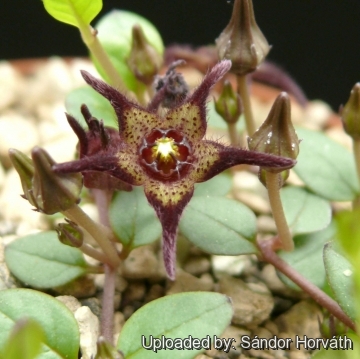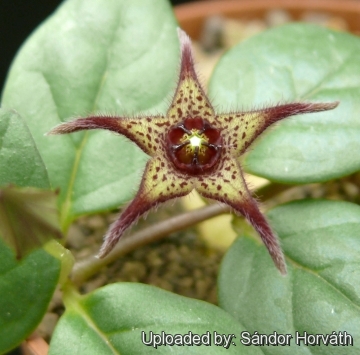




Your support is critical to our success.
- Encyclopedia of SUCCULENTS
- Encyclopedia Index
- Families
- Genera
- Species
- Asclepiadaceae
- Brachystelma
- Caudiciforms
Since 4 Aug 2013

Origin and Habitat: South Africa, Mpumalanga mainly in the vicinity of Kaapsehoop.
Habitat and Ecology: Mountains. Found in a few localities on the southern escarpment, in sandy, rocky grassland. It grows in white sandy quartzite-derived soils near the village of Kaapsche Hoop. The population trend is stable.
Synonyms:
- Brachystelma bruceae R.A.Dyer
Description: Brachystelma bruceaeSN|32324]]SN|32334]] is a diminutive floral gem of the mountains of Mpumalanga where it often goes unnoticed. It is a perennial herbaceous plant with slim, dark red prostrate stems radiating from a a medium-sized round tuber. Paired small heart-shaped leaves adorn these shoots, they are dark green with red midribs and have a slightly metallic appearance. The star-shaped, solitary flower, at most 10 mm wide, is a rich ruby, or purple-maroon, shiny and without hairs. It opens flat and has a conspicuous corona. Minute sepals peep out between the corolla lobes.
Derivation of specific name: This species was named after Miss Eileen A. Bruce (1905– 1955), British botanist at Kew who worked on African plants and also worked in South Africa 1946–1952.
Tuber (caudex): Flattened, 5-7 cm in diameter, mostly underground often with slightly bowl-shaped central area.
Stem: Aerial shoot, several, prostrate, to 20 cm long, branching from the base to 20 cm long, stiffly hairy, purple.
Leaves: Shortly petiolate, arranged in an alternate or opposite position, ovate, somewhat fleshy, 10-15 mm long, 5-10 mm broad, upper face and midrib hispid
Inflorescence: Sessile, one-flowered produced towards the shoot ends. Pedicels 7-15 mm long, hairy. Sepals lanceolate-subulate, c. 3 mm long, spreading, roughly hairy. Corolla, star-shaped, 10-16 mm in diameter, purple to pale brown-red, smooth. Corolla-tube nearly flat, short. Corolla-lobes 4-6 mm long, triangular to ovate-lanceolate, margins somewhat revolute. Corona sessile, overtopping the corolla, purple to pale brown-red, c. 3 mm across, basally united and cup-shaped. Outer corona-lobes pouch-like, outer margin emarginate. Inner corona-lobes shortly linear, incumbent on the anthers.
Blooming season: Flowering time is mainly summer.
Fruits (follicles): One or two follicles per flower,
Similar species: Brachystelma bruceaeSN|32334]]SN|32334]] is very similar in habit and flower morphology to Brachystelma pulchellumSN|32334]]SN|32324]], but has larger, concolorous, purple-chocolate flowers, while in typical B. pulchellum from Natal the slightly saucer-shaped corolla is consistently smaller, and it has a shallower outer corona.
Bibliography: Major references and further lectures
1) Focke Albers, Ulrich Meve “Illustrated Handbook of Succulent Plants: Asclepiadaceae: Asclepiadaceae”, Volume 4 Springer Science & Business Media, 2002
2) Dyer, R.A. 1980. “Brachystelma, Ceropegia and Riocreuxia.” In: O.A. Leistner (ed). Flora of Southern Africa 27 Part 4:1-88. Botanical Research Institute, Pretoria.
3) Dyer, R.A. 1983. “Ceropegia, Brachystelma and Riocreuxia in southern Africa.” A.A. Balkema, Rotterdam, Netherlands.
4) J.P. Roux “Flora of South Africa”, 2003
5) Foden, W. & Potter, L. 2005. "Brachystelma bruceae R.A.Dyer subsp. bruceae". National Assessment: Red List of South African Plants version 2015.1. Accessed on 2016/01/14
6) Jo Onderstall “Sappi - Wild flowers guide: Mpumalanga & Northern Province” Jacana Media 1996
7) Gideon Smith, Neil R. Crouch “Guide to Succulents of Southern Africa” Struik Nature, 2009
8) Urs Eggli, Leonard E. Newton “Etymological Dictionary of Succulent Plant Names” Springer Science & Business Media, 29 June 2013

Brachystelma bruceae Photo by: Sándor Horváth

Brachystelma bruceae Photo by: Sándor Horváth
Cultivation and Propagation: Brachystelma bruceaeSN|32334]]SN|32334]] is hardy in cultivation.
Soil: It grows best in deep earthenware pots in a very draining but rich soil. An error in cultivation may produce unsightly holes in the tuber.
Exposure: In cultivation the plants are usually grown in semi shade, with the tubers wholly or (preferably) partially exposed to prevent scorching and rotting of the roots. When the plants are kept in half a day's sunlight their natural compact habit is maintained, a characteristic feature of most plants in habitat
Hardiness: It should be overwintered in the greenhouse at temperatures over 12°C (avoid letting temperatures drop lower than 5° C).
Water requirements: This plant can take a good deal of water during active growth and should be watered only when not dormant. Keep dryish in winter.
Traditional uses: The tuber is sometimes eaten by the Hottentots and called Hottentot's bread, when eaten raw it tastes bitter.
Reproduction: This species can be reproduced by seeds.
| Your Actions | |
|---|---|
| Back to Brachystelma index | |
| Back to Asclepiadaceae index | |
 |
Back to Succulents Encyclopedia index |
Privacy stantement - Terms and conditions - How to cite - About us - Feedback - Donate




